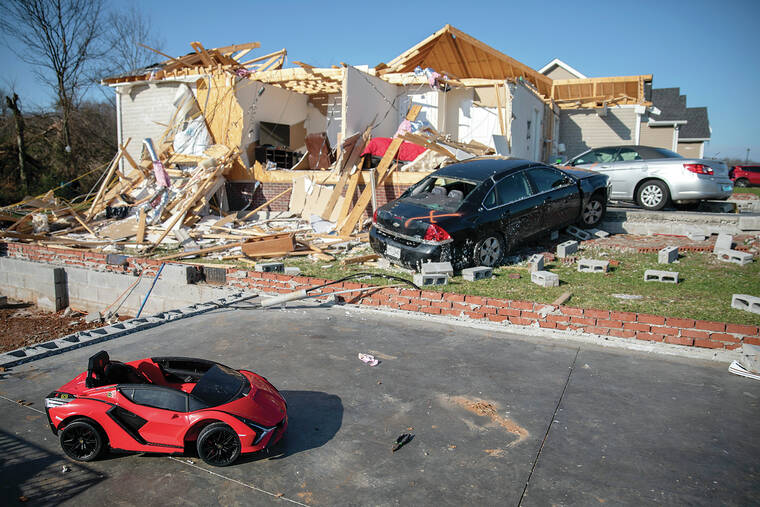Deadly extreme weather year for US as carbon emissions soar
The United States staggered through a steady onslaught of deadly billion-dollar weather and climate disasters in an extra hot 2021, while the nation’s greenhouse gas emissions last year jumped 6% because of surges in coal and long-haul trucking, putting America further behind its 2030 climate change cutting goal.
Three different reports released Monday, though not directly connected, paint a picture of a U.S. in 2021 struggling with global warming and its efforts to curb it.
ADVERTISING
A report from the Rhodium Group, an independent research firm, on Monday said that in 2021 America’s emissions of heat-trapping gas rebounded from the first year of the pandemic at a faster rate than the economy as a whole, making it harder to reach the country’s pledge to the world to cut emissions in half compared to 2005 by 2030. And last year was the deadliest weather year for the contiguous United States since 2011 with 688 people dying in 20 different billion-dollar weather and climate disasters that combined cost at least $145 billion, the National Oceanic and Atmospheric Administration said Monday.
That was the second highest number of billion-dollar weather disasters — which are adjusted for inflation with records going back to 1980— and third costliest.
“It was a tough year. Climate change has taken a shotgun approach to hazards across the country,” said NOAA climatologist and economist Adam Smith, who compiles billion-dollar weather disasters for NOAA.
Scientists have long said human-caused climate change makes extreme weather nastier and more frequent, documenting numerous links to wild and deadly weather events. They say hotter air and oceans and melting sea ice alter the jet stream which brings and stalls storm fronts, makes hurricanes wetter and stronger, while worsening western droughts and wildfires.
Last year’s weather disasters included a record shattering heat wave in the Pacific Northwest where temperatures hit 116 degrees in Portland, a devastating and deadly cold icy storm in Texas, a widespread windstorm called a derecho, four hurricanes that caused intense damage, deadly tornado outbreaks, mudslides and a persistent drought and lots of wildfires.
While 2020 set the record for the most billion-dollar disasters, in 2021 “the extremes seemed a bit more profound than in 2020,” Smith said.
Last year, billion dollar weather disasters were more than twice as deadly as in 2020, when those extremes killed 262 people. The last deadlier year was 2011. Hurricane Maria in 2017 killed nearly 3,000 people in Puerto Rico, which isn’t part of the contiguous United States.
Changes in where people live and housing vulnerability were factors, Smith said, “but the 800-pound gorilla in the room is, of course, climate change, because that’s accelerating all of these trends in regards to disaster potential for damage.”
“We’re having these compound cascading events one after another, after another,” Smith said. “A lot of trends are going in the wrong direction.”
The last five years have cost $742 billion in 86 separate billion-dollar weather disasters, an average of more than 17 a year, a new record. That’s nearly $100 billion more than the combined total of all the billion-dollar disasters from 1980 to 2004, adjusted for inflation and far more the three billion-dollar disasters a year that the nation averaged in the 1980s.
“That’s exactly what I’d expect with climate change because climate change is essentially supercharging many types of extreme weather, making heatwaves, droughts, wildfires, intense rainfall, flooding, and storms more severe, destructive and deadly,” said Jonathan Overpeck, dean of environmental studies at the University of Michigan.


